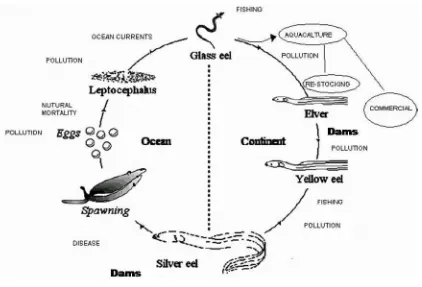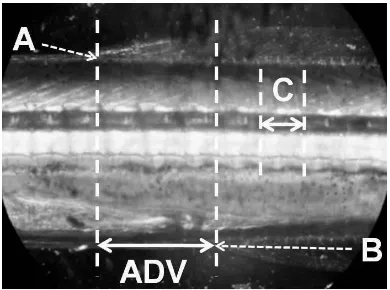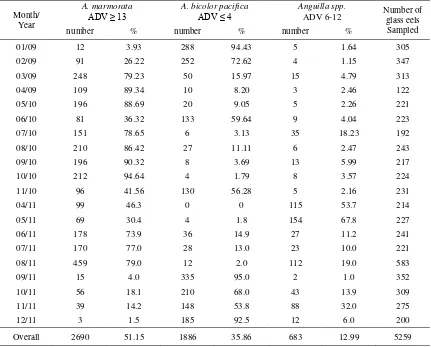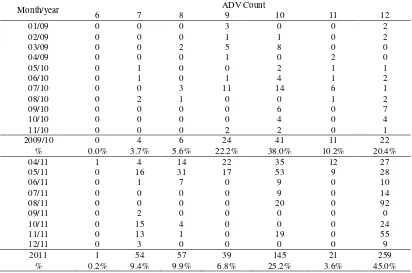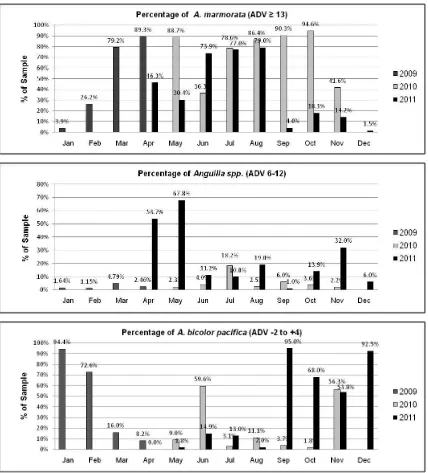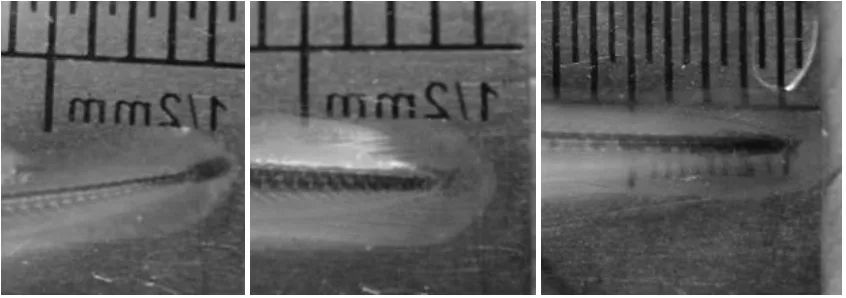Species composition of glass eels (
Anguilla
spp
.
) recruiting to the Palu River,
Central Sulawesi
[Komposisi spesies
glass eels
(
Anguilla
spp.) yang beruaya di muara Sungai Palu,
Sulawesi Tengah]
Novalina Serdiati
1, , Samliok Ndobe
1, Abigail Moore
2, Deddy Wahyudi
21
Aquaculture Study Program,Faculty of Animal Husbandry and Fisheries, Tadulako University (UNTAD), 2
Fisheries and Marine Science Institute (STPL)
Aquaculture Study Program,Faculty of Animal Husbandry and Fisheries, Tadulako University (UNTAD), Kampus Bumi Tadulako, Palu 94118, Central Sulawesi
Surel: novaserdiati@yahoo.co.id
Diterima: 4 Oktober 2012; Disetujui: 5 November 2013
Abstract
Demand for tropical eel seed has been increased and many tropical eel populations are under pressure. To conserve eel biodiversity and manage eel populations sustainably, it is necessary to identify eel species and their recruitment patterns at regional and watershed scales. The research objective was to determine the species composition and temporal recruit-ment patterns of glass eels recruiting to Palu River in Central Sulawesi. Glass eels sampling were conducted in January-April 2009, May-November 2010 and January-April-December 2011. Identification under anaesthetic (15-17.5 ppm clove oil solution) was based mainly on the number of ano-dorsal vertebrae (ADV). Species composition was dominated by two commercially species, Anguilla marmorata and A. bicolor pacifica with substantial variation and no clear temporal patterns. Specimens of other species that important from conservation and biodiversity aspects were present at each month but cannot be accurately identified using the ADV method. DNA analysis method is required to identify these specimens.
Keywords: Anguilla marmorata, Anguilla bicolor pacifica, anodorsal vertebrae, species identification.
Abstrak
Permintaan benih ikan sidat tropis meningkat dan banyak populasi sidat tropis telah mengalami tekanan. Untuk meles-tarikan keanekaragaman hayati ikan sidat dan mengelola populasi sidat secara berkelanjutan, perlu identifikasi spesies maupun pola rekrutmennya pada skala regional maupun daerah aliran sungai. Tujuan penelitian adalah menentukan komposisi jenis dan pola rekrutmen glass eels secara temporaldi Sungai Palu, Sulawesi Tengah. Sampling dilakukan pada bulan Januari-April 2009, Mei-November 2010, dan April-Desember 2011. Identifikasi contoh ikan dalam kea-daan pingsan (menggunakan larutan minyak cengkeh 15-17.5 ppm) terutama didasarkan pada jumlah anodorsal verte-brae (ADV). Komposisi jenis didominasi oleh dua spesies bernilai ekonomis, yaitu Anguilla marmorata dan Anguilla bicolor pacifica, namun sangat bervariasi tanpa pola musiman atau tahunan yang jelas. Setiap bulan terdapat beberapa spesimen dari spesies lain, yang penting dari aspek konservasi dan biodiversitas, namun tidak dapat diidentifikasi secara pasti dengan metode ADV. Untuk mengidentifikasi spesimen tersebut dibutuhkan metode analisa genetik (DNA).
Kata penting: Anguilla marmorata, Anguilla bicolor pacifica, anodorsal vertebrae, identifikasi spesies.
Introduction
Freshwater eels (Genus Anguilla) are a valuable fisheries commodity, extensively traded globally (Silfvergrip 2009). All eels of this genus have an unusual catadromous lifecycle, making a one-way spawning migration to deep ocean wa-ters, their larvae carried by ocean currents and recruit to freshwater habitats as glass eels (Tesch 2003). A simple model of the freshwater eel life-cycle including the major causes of eel mortality
during their various life stages is shown in Figure 1.
Source: adapted from Liangming et al., 2007
Figure 1. Conceptual model of the eel lifecycle and major causes of mortality
2009, Oliveira 2010), captive breeding is still at the experimental stage and freshwater eel aqua-culture worldwide is therefore totally reliant on wild-caught seed. The European eel Anguilla anguilla is considered critically endangered by the International Union for the Conservation of Nature (IUCN) Red List, and has been listed in CITES Appendix II since 2007 (Freyhof & Kottelat 2010). In response to the growing con-cern over freshwater eel stocks, exploitation of
Anguilla japonica in Japan and A. rostrata in the USA have also come under increasingly strict regulation.
The ongoing need for glass eels to supply the eel grow out industry resulted in an increas-ing demand for tropical eel seed, includincreas-ing indo-nesian glass eels. Many tropical eel stocks are now exploited from glass eel to silver eel stage as well as suffering from habitat degradation (Casselman & Cairns 2009, ICES 2010). The Indonesian Government had long issued (little
known) restrictions on the export of eel seed, however in 2009 new legislation was promul-gated banning the export of eel seed, with the avowed aim of encouraging the development of incountry aquaculture (grow out). Under this regulation (Peraturan Menteri Kelautan dan Perikanan Republik Indonesia Nomor Per. 18/Men/2009 tentang Larangan Pengeluaran Benih Sidat (Anguilla spp.) dari Wilayah Negara Republik Indonesia ke Luar Wilayah Negara Republik Indonesia), eel seed is defined as "small eels with a length up to 35cm and/or a weight of up to 100g and/or a diameter up to 2.5 cm". This definition covers the glass eel stage through to yellow eels which may be several years old.
(Aoyama 2009). Glass eels are known to recruit in multispecies schools to many tropical rivers, including several rivers around the island of Sulawesi, and to exhibit marked seasonal differ-ences in species composition (Arai et al. 1999, Sugeha et al. 2001, Muchsin et al. 2002, Amir et al. 2010).
This diversity is a challenge for aquacul-ture as from an economic viewpoint the efficient grow-out of glass eels requires mono-species seed of commercially valuable species. It is therefore important to identify freshwater eel species at the glass eel stage, preferably in live condition. The freshwater eel identification key developed to assist in the implementation of CITES regulations for A. anguilla (Silfvergrip 2009) described a number of external morpho-logical characteristics, none of which were suit-able for determining the species of live glass eels. Genetic methods available at the time would be capable of distinguishing between species at any stage in the life cycle, but were considered unsuitable for sorting large numbers of live glass eels; despite considerable advances such as the semi-multiplex PCR since developed by Fahmi et al. (2013), genetic methods are still not appli-cable for this purpose.
It is clear that to conserve eel biodiversity and manage Indonesian eel resources sustainably, species distribution and recruitment patterns need to be identified at regional and watershed scales. Indeed, a strategy for eel resource use in Indo-nesia developed by Affandi (2005) stated that identification of eel resources should be a prior-ity. At a regional level, larvae (leptocephali) of four species (Anguilla marmorata, A. celebes-ensis, A. borneensis and A. bicolor pacifica) had been reported in the Makassar Straits (Aoyama et al. 2003, Miller 2009, Wouthuyzen et al. 2009).
Glass eels were known to recruit to the Palu Ri-ver, flowing into Palu Bay, which opens onto the Makassar Straits; however there were no data available on the species composition of eels rec-ruiting to this river.
The main research objective of this multi-year research program which began in 2009 was to determine the species composition and tem-poral recruitment patterns of glass eels recruiting to Palu River. In order to promote sustainable use, in particular efficient and responsible aqua-culture, an identification method was required that could not only identify glass eels but also sort them to provide live and healthy mono-spe-cies eel seed of commercially valuable spemono-spe-cies. Initial results of identification and sorting method development as well as glass eel composition were reported in Ndobe et al. (2010). This paper presents a summary of results to the end of 2011.
Materials and methods
Glass eels recruiting to the Palu River es-tuary were sampled in January-April 2009, May-November 2010 and April-December 2011. The location of Palu Bay and the Palu River are shown in Figure 2.
Collection using hand-held scoop nets took place at night on a rising tide during the dark/new moon phase (day 28-02 of the lunar cycle). Before and after identification the glass eels were kept in 100 litre aquaria with aeration, filled with 40 litres of water and provided with shelter (piles of small river rocks). Anesthesia of the glass eels during the identification process followed the protocol using a 15-17.5 ppm solu-tion of clove oil developed during 2009/2010 (Ndobe et al. 2010).
de-Figure 2. Map showing the location of Palu Bay, Palu River and the sampling site
A: root of the dorsal fin; B: root of the anal fin; C: one vertebra; ADV: vertebrae to be counted to obtain the ano-dorsal vertebrae count. Note: in this specimen ADV = 3
Table 1. ADV counts for four eel species and ADV categories used
ADV counts based on Tabeta et al. (1976a) and Silfvergrip (2009)
ADV categories used in this research
Species ADV Count Species ADV Count
A. marmorata 13 to 18 A. marmorata ≥ 13
A. bicolor pacifica -6 to +3 A. bicolor pacifica ≤ 4
A. celebesensis 6 to 12
Anguilla spp.* 6 to 12
A. borneensis 7 to 12
* Specimens with ADV values in the 6-12 range cannot be identified based on ADV and were therefore categorised as
Anguilla spp.
Figure 4. Tail Spot (TS) shapes of A. marmorata/A. celebesensis (left) and A.bicolor pacifica (right) according to Tabeta et al. (1976b)
scribed in Tabeta et al. (1976a). The number of anodorsal vertebrae (between the root of the anal fin and the dorsal fin) can be used to distinguish between species or species groups as shown in Table 1. In the glass eel stage, the body is still transparent, so that the vertebrae could be seen and counted as shown in Figure 3. A binocular microscope with 20 times magnification was used.
Although the ADV method is effective, it requires considerable resources in terms of time, trained personnel and equipment. A second me-thod was developed to provide a faster, simpler method for larger-scale glass eel identification and sorting. During metamorphosis from trans-parent glass eel to pigmented benthic elver, mela-nophores are first formed in the head and tail regions (Usui 1976). The melanophores in the tail area are called the caudal spot or tail spot (TS), the shape of which varies between species (Silvfergrip 2009). The tail spot shapes of A. marmorata/A. celebesensis and A. bicolor
paci-fica glass eels according to Tabeta et al. (1976b) are shown in Figure 4. Tail spots were observed under anesthetic using a binocular microscope and a variety of magnifying glasses.
The ADV data were tabulated and lyzed graphically. Tail Spot (TS) data were ana-lyzed descriptively and compared with ADV data to evaluate the accuracy of the TS method using the various magnifying glasses obtained. A con-cordance rate of 95% or higher was considered to be acceptable.
Results
Anodorsal vertebrae (ADV) count
Just over half of the total sample (51.15%) were identified as Anguilla marmorata (ADV ≥
13). This was the dominant species in 10 out of 20 months, and A. marmorata glass eels were present every month although sometimes in very low numbers. Over one third (35.86%) of the total sample were identified as A. bicolor
paci-fica (ADV ≤ 4). This was the dominant species in
eight out of the twenty months and was not pre-sent in only one month (April 2011). Numbers were also very low (less than 10 specimens) in four other months (July, September and October 2010 and May 2011).
Figure 5. Overall ADV distribution of glass eels recruiting to the Palu River sampled in January-April 2009, May-November 2010 and April-September 2011
Table 2. Species composition of glass eels recruiting to the Palu River estuary
Month/ Year
A. marmorata
ADV ≥ 13 A. bicolor pacifica ADV ≤ 4 Anguilla spp.ADV 6-12 Number of glass eels
Sampled
number % number % number %
01/09 12 3.93 288 94.43 5 1.64 305
02/09 91 26.22 252 72.62 4 1.15 347
03/09 248 79.23 50 15.97 15 4.79 313
04/09 109 89.34 10 8.20 3 2.46 122
05/10 196 88.69 20 9.05 5 2.26 221
06/10 81 36.32 133 59.64 9 4.04 223
07/10 151 78.65 6 3.13 35 18.23 192
08/10 210 86.42 27 11.11 6 2.47 243
09/10 196 90.32 8 3.69 13 5.99 217
10/10 212 94.64 4 1.79 8 3.57 224
11/10 96 41.56 130 56.28 5 2.16 231
04/11 99 46.3 0 0 115 53.7 214
05/11 69 30.4 4 1.8 154 67.8 227
06/11 178 73.9 36 14.9 27 11.2 241
07/11 170 77.0 28 13.0 23 10.0 221
08/11 459 79.0 12 2.0 112 19.0 583
09/11 15 4.0 335 95.0 2 1.0 352
10/11 56 18.1 210 68.0 43 13.9 309
11/11 39 14.2 148 53.8 88 32.0 275
12/11 3 1.5 185 92.5 12 6.0 200
Figure 6. Monthly glass eel species composition (ADV) in 2011
Table 3. Specimens with ADV counts in the 6-12 range by month/year
Month/year ADV Count month sampled in 2009/2010, the majority (82%) were collected in 2011 with very low numbers in two months (September and December). The monthly ADV values of specimens in this ca-tegory are shown in Table 3, while aggregate
values for 2009/10 and 2011 are shown in Figure 8.
Figure 7. Percentage of each species/ADV category by month and year
range between sampling periods (months/years). Within this group, all values from 6 to 12 were observed. The dominant ADV count in 2009/10 was 10, followed by 9 and 12; in 2011, ADV 12 was dominant, comprising nearly half the sample (45%) followed by ADV 10.
Tail spot (TS) shape
The tail spot shapes given in Tabeta et al. (1976b) are for A. bicolor (broom or brush shaped) and for the two species A. marmorata
eels from Poso River, which differed from that of the A. marmorata specimens, is shown in Figure 9.
The tail spots of most Anguilla spp. glass eels from the Palu River were similar to Figure 9. This can be seen in photographs of Anguilla spp.,
A. marmorata and A. bicolor pacifica tail spots taken with a digital camera using macro function directly (Figure 10) and via the microscope ocu-lar (Figure 11).
To replace the binocular microscope used in Figure 11, the first suitable magnifying glass
Figure 8. ADV distribution of Anguilla spp. (ADV 6-12) sampled
Note: arrow shaped melanophores over terminal vertebrae similar to A. marmorata; "broom" shape similar to but ge-nerally somewhat paler and less dense (bushy) than in A. bicolor pacifica and sometimes somewhat ragged at the rear (outer) edge
Figure 9. Sketch of the tail spot (TS) of Anguilla celebesensis glass eels
Left: A. bicolor pacifica; Centre: Anguilla spp.; Right: A. marmorata
Anguilla bicolor pacifica tail spot Anguilla marmorata tail spot
Anguilla spp. tail spot with "arrow" and "brush" – two examples
Figure 11. Examples of glass eel tail spots from Palu River
identified was an antique biologist’s field glass with a secondary magnification blister. This en-abled the observer to view tail spots with a reso-lution similar to that shown in Figure 10. Avail-able modern alternatives were tested with the help of student volunteers, trials which also add-ressed a second challenge which is assessing whether the skill in identification acquired by the researchers could readily be transferred. These trials showed that monocles produced for use in watch repair (rated as X 4 and X 5 magnification respectively) could provide similar resolution to the antique field glass and results consonant with the use of the binocular microscope (X 20 magnification).
The TS method applied to glass eels from Palu River was 100% accurate in separating shortfin eels (A. bicolor pacifica) from long fin eels (all other species likely to be found in the area). In separating A. marmorata (ADV ≥ 13)
from other long-fin (ADV 6-12) glass eels during 2009 and 2010, the TS method was over 95% consonant with ADV counts and considered ac-ceptable. The few misidentifications were mostly
A. marmorata(ADV ≥ 13) identified as Anguilla
did not conform to the pattern sketched in Figure 9, and the TS identification was less than 95% consonant with ADV counts.
Discussion
Species composition dominancy and patterns
During 2009 and 2010, in every sampling month the glass eels recruiting to the Palu River were predominantly A. marmorata and/or A. bi-color pacifica, with low or very low numbers of glass eels in the 6 to 12 ADV range. This lead to an initial conclusion by Ndobe et al. (2010) that these two economically valuable species, suitable as seed for eel aquaculture activities, each oc-curred in large numbers but on a seasonal basis, making confirmation of the apparent seasonality of recruitment in each of these species an im-portant prerequisite for the planning and imple-mentation of ecologically and economically sustainable exploitation.
The results of the 2011 sampling put in question many of the initial (tentative) conclusi-ons based on 2009/10 data, in particular regard-ing species dominance and seasonality. In two months (April and May 2011) the sample was dominated by glass eels in the ADV 6-12 range, and in five other months this group constituted more than 10% of the sample. A. marmorata
numbers were lower (in some cases much lower) than in previous years for all but one month (June) sampled in 2011. In addition, peaks in the recruitment of all species occurred at different times of year in 2011 compared to 2009/2010.
The cause or causes of these inter-annual variations in seasonality and abundance (absolute and relative) are not known, but are likely due to a combination of factors. As discussed in Kuroki
et al. (2012) primarily in respect of Anguilla lu-zonensis (but also A. marmorata, A. celebesensis
and A. bicolor pacifica), factors which could
fluence the recruitment of each eel species in-clude those which affect the survival rate, timing and output (reproductive success) of breeding eels as well as the transport via ocean currents of the eel larvae as leptocephali and throughout the metamorphosis to the glass eel stage.
The spawning grounds supplying glass eels which recruit to the Palu River are not known with certitude, and evaluation of these factors will not be a simple task, even for the two commercially valuable species which between them comprise the majority of the observed co-horts. It is likely that A. marmorata glass eels re-cruiting to the Palu River form part of a panmic-tic Japan-Sulawesi population based on the ge-netic analysis by Minegishi et al. (2008), and originate from the spawning ground in the north eastern Pacific Ocean postulated by Miller et al. (2002) and now generally accepted (Righton et al. 2012).The spawning ground(s) of A. bicolor pacifica do not appear to have been identified; however current and species distribution maps in Aoyama (2009) and Fahmi et al. (2102) indicate that both A. marmorata and A. bicolor pacifica
appear to recruit to the northern Makassar Straits via the Indonesian Throughflow.
Righton et al. (2012) state that “even to -day, with the advent of marine remote sensing, genetic and otolith analyses, electronic tagging, and investigative computer modelling, there are many fundamental questions about Anguilla spp.
migrations that remain unanswered”. They fur
over time periods of several years or even deca-des which cannot be detected based on the short time-frame of existing data. It is also possible that patterns are changing or will change due to global shifts in climate and oceanic circulation.
Species composition of the 6-12 ADV range
There are at least three tropical eel species now known to have between 6 and 12 ano-dorsal vertebrae. These are A. celebesensis, A. borneen-sis, and A. luzonensis (7-10 ADV, Kuroki et al. 2012) now officially recognized as senior syno-nym of A. huangi (Watanabe et al. 2013). Lep-tocephali of both A. celebesensis and A. bornee-nsis have been identified in the Makassar Straits (Wouthuyzen et al. 2009). Although as yet un-identified, available information indicates that the spawning ground of A. borneensis is most likely in or near to the Makassar Straits.
The known spawning ground of A cele-besensis is in Tomini Bay (Aoyama et al. 2003). It is not impossible that larvae could, at least on a seasonal or occasional basis, be carried out of the bay by currents which would eventually join the Indonesian Throughflow and thus enter the Ma-kassar Straits. It is also not impossible that, like
A. marmorata, A. celebesensis may have more than one spawning ground.
The cryptic species A. luzonensis, morpho-logically almost undistinguishable from A. cele-besensis, was identified in the Philippines thro-ugh genetic analysis (Watanabe et al. 2009). Re-search on leptocephali indicates that the spawn-ing ground for this species is close to the north
and A. celebesensis are the same (Figure 2, left). Leander et al. (2012) found that the TS of A. marmorata and A. luzonensis were indistinguish-able, and resembled that described by Tabeta et al. (1976b), and also opined that that A. celebes-ensis specimens previously reported from Tai-wan were most likely misidentified A. luzonensis.
Ndobe et al. (2010) found a difference between the TS of glass eels from the Poso River known to be A. marmorata and A. celebesensis
and a similar difference was observed in the ma-jority of the ADV 6-12 specimens from the Palu River (Figure 11). It is possible that some of the misidentified glass eels, especially those with TS resembling that of A. marmorata, could be A. lu-zonensis. We consider that some leptocephali en-trained in the NEC could conceivably be carried towards Sulawesi, join the Indonesian Through-flow, enter the Makassar Straits and hence reach Palu Bay and the Palu River estuary. This would be similar to the migration of A. marmorata
implicated by the maps in Aoyama (2009) and Fahmi et al. (2012). This migration route would also be consonant with Kuroki et al. (2012) who also consider that historically A. luzonensis glass eels may have been misidentified as A. celebes-ensis, and furthermore that it is possible A. luzon-ensis leptocephali might, at least occasionally, be carried by ocean currents to northern Sulawesi.
mig-rate. Therefore, when sorting the two more nu-merous species to provide mono-species A. mar-morata and A. bicolor pacifica eel seed, it should be a priority to separate glass eels of the ADV 6-12 group and return them to the wild.
The tail spot observations as well as the variability in ADV count distribution within and between months strengthen the contention that there may be more than one species with ADV counts in the 6-12 range recruiting to the Palu River. Furthermore, the size of these glass eels tended to exhibit a seemingly bi-modal tion rather than the normal (bell curve) distribu-tion of the aggregated A. marmorata and A. bico-lor pacifica samples. This could be an artefact of sampling size, especially in the months with a cruiting at the same time.
As there are at least three species which could possibly recruit to the Palu River with ADV counts in the 6-12 range, it is important from a biodiversity and biogeographical pers-pective to identify the species actually present. The genomes of all the eels species known or suspected to recruit to the Palu River have been identified and stored in the global DNA/protein database GenBank (Minegishi et al. 2009) and protocols for DNA-based identification of one or several species have now been developed, for ex-ample Fahmi et al. (2013).However, in view of observed inter-seasonal and inter-annual vari-ability in recruitment, sample selection would need to cover the full ADV range and several months at least (ideally over a time frame of one or more years) in order to be certain of iden-tifing the full range of species present.
Conclusion
At least three species recruited to the Palu River during the research period. For 18 out of 20 months, species composition was dominated by Anguilla marmorata and/or A. bicolor paci-fica, both commercially valuable species. Speci-mens of one or more other species which cannot be accurately identified by the methods (ADV and tail spot) used were present each month, do-minated the samples collected in two out of 20 months, and are considered important from con-servation and biodiversity aspects. Genetic analy-sis is considered necessary to determine the iden-tity of these glass eels and thus the full species composition of glass eels recruiting to the Palu River.
The ADV method using clove oil as an anesthetic is considered applicative and suitable for sorting small quantities of glass eels, to pro-duce mono-species seed of two commercially va-luable species and allow glass eels of non-com-mercial species to be separated and released back to the wild. The tail spot (TS) method requires further development but shows promise as a low-technology, low cost method for separating larger quantities of eel seed.
Acknowledgments
Abdul Rahman, Renol, Wulan Yuniarti, Gita Afriany, Muhammad Muttaqin and, as well as the anonymous reviewers who provided valuable input to improve this paper.
References
Affandi R. 2005. Strategi pemanfaatan sumber daya ikan sidat Anguilla sp. di Indonesia.
Jurnal lktiologi Indonesia, 5(2):77-81. (in Indonesia)
Amir F, Mallawa A, Budimawan, Tresnati J. 2010. Rekrutmen larva ikan sidat (Anguilla
spp.) ke Perairan Malunda, Sulawesi Barat.
Jurnal Sains dan Teknologi, 10(1):1-6.
Aoyama J. 2009. Life history and evolution of migration in catadromous eels (Anguilla
sp.). Aqua-Bio Science Monograph, 2(1):1-42.
Aoyama J, Wouthuyzen S, Miller MJ, Inagaki T, Tsukamoto K. 2003. Short-distance spawn-ing migration of tropical freshwater eels.
The Biological Bulletin, 204(1):104-108.
Arai T, Aoyama J, Limbong D, Tsukamoto K. 1999. Species composition and inshore migration of the tropical eels Anguilla spp. recruiting to the estuary of the Poigar River, Sulawesi Island. Marine Ecology Progress Series, 188:299-303.
Casselman JM, Cairns DK (eds). 2009. Eels at the edge: Science, status, and conservation concerns. American Fisheries Society. Summary. ttp://www.afsbooks.org/54058C [download 06 March 2010]
Fahmi MR, Pouyaud L, Berrebi P. 2012. Distri-bution of tropical eel Genus Anguilla in In-donesia water based on Semi-Multiplex PCR. Indonesian Aquaculture Journal, 7(2):139-148
Fahmi MR, Solihin DD, Soewardi K, Pouyaud L, Shao Z, Berrebi P. 2013. A novel semi-multiplex PCR assay for identification of tropical eels of genus Anguilla in Indone-sian waters. Fisheries Science, 79(2):185-191
Fisheries Forum 2003. Worldwide decline of eel resources necessitates immediate action: Québec declaration of concern. Fisheries Forum, 28(12):28-30
Freyhof J, Kottelat M. 2010. Anguilla anguilla. In: IUCN 2011. IUCN Red list of threaten-ed species. Version 2011.2.
<www.iucnredlist.org>. [Download 12 May 2012]
ICES. 2010. Report of the 2009 session of the
Joint EIFAC/ICES Working Group on Eels.
Göteborg, Sweden,7-12 September 2009. EIFAC Occasional Paper No. 45. European Inland Fisheries Advisory Commission, International Council for the Exploration of the Sea (ICES). Copenhagen, Denmark. Kuroki M, Miller MJ, Aoyama J, Watanabe S,
Yoshinaga T, Tsukamoto K. 2012. Offshore spawning for the newly discovered anguil-lid species Anguilla luzonensis (Teleostei: Anguillidae) in the Western North Pacific.
Pacific Science, 66(4):497-507.
Leander NJ, Shen KN, Chen RT, Tzeng WN. 2012. Species composition and seasonal occurrence of recruiting glass eels (Anguilla spp.) in the Hsiukuluan River, Eastern Taiwan. Zoological Studies, 51(1):59-71. Liangming C, Xinyu C, Yu C, Ping F, Yuyu H,
Haiyan L, Mingyan L, Cong W. 2007. Eel population and solution model. Roskilde University, UK. 66 p.
Lockman PM, Young G. 2000. Induced spawn-ing and early ontogeny of New Zealand freshwater eels (Anguilla dieffenbachii and A. australis). New Zealand Journal of Ma-rine and Freshwater Research, 34(1):135-145.
Miller M, Mochioka N, Otake T, Tsukamoto K. 2002. Evidence of a spawning area of
Anguilla marmorata in the western North Pacific. Marine Biology, 140(4):809-814.
Miller MJ. 2009. Ecology of anguilliform lepto-cephali: Remarkable transparent fish larvae of the ocean surface layer. Aqua-Bio Sci-ence Monograph, 2(4):1-94.
Minegishi Y, Aoyama J, Tsukamoto K. 2008. Multiple population structure of the giant mottled eel, Anguilla marmorata. Mole-cular Ecology, 17(13):3109-3122.
Minegishi Y, Aoyama J, Inoue JG, Azaza RV, Tsukamoto K. 2009. Inter-specific and sub-specific genetic divergences of freshwater eels, genus Anguilla including a recently described species, A. luzonensis, based on whole mitochondrial genome sequences.
Coastal Marine Science, 33:64-77.
Prosiding Forum Nasional Sumber Daya Perikanan Sidat Tropik 2002. pp. 78-83. Ndobe S, Moore A, Serdiati N, Nilmawati. 2010.
Glass eels (Anguilla sp.) recruiting to Palu River, Central Sulawesi, Indonesia. Pro-ceedings of the International Conference of Indonesia Aquaculture 2010 (ICAI), 25-28 October 2010, Hang Tuah University, Sura-baya, Indonesia.
Oliveira K, Hable W.E. 2010. Artificial matura-tion, fertilizamatura-tion, and early development of the American eel (Anguilla rostrata). Cana-dian Journal of Zoology, 88(11):1121-1128.
Palstra A, van den Thillart G. 2009. Artificial maturation and reproduction of the European eel. In: van de Thillart G, Dufour S, Rankin JC (eds.). Spawning migration of the European eel: reproduction index, a useful tool for conservation management. Fish & Fisheries Series, 30. Springer, New
Silfvergrip AMC. 2009. CITES identification guide to the freshwater eels (Anguillidae) with focus on the european eel Anguilla anguilla. The Swedish Environmental Pro-tection Agency, Sweden. 135 p.
Sugeha HY, Arai T, Miller MJ, Limbong D, Tsukamoto K. 2001. Inshore migration of the tropical eels Anguilla spp. recruiting to the Poigar River estuary on north Sulawesi Island. Marine Ecology Progress Series, 221: 233-243
Tabeta O, Takai T, Matsui I. 1976a. The sec-tional counts of vertebrae in the anguillid elvers. Japanese Journal of Ichthyology, 22(4):195-200.
Tabeta O, Tanimoto T, Takai T, Matsui I, Imamura T. 1976b. Seasonal occurrence of anguillid elvers in Cagaya River, Luzon Island, the Philippines. Bulletin of the Ja-panese Society of Scientific Fisheries 42(4): 421-426.
Tanaka H, Kagawa H, Ohta H, Unuma T, Nomura K. 2003. The first production of glass eel in captivity: fish reproductive phy-siology facilitates great progress in aquacul-ture. Fish Physiology and Biochemistry, 28(1-4):493-497.
Tesch FW. 2003. The eel. Blackwell Science Ltd, Oxford, UK. 418 p.
Usui A. 1976. Eel culture. Fishing News Books Ltd. West Byfleet, England. 186 p.
Watanabe S, Aoyama J, Tsukamoto K. 2009. A new species of freshwater eel Anguilla luzonensis (Teleostei: Anguillidae) from Luzon Island of the Philippines. Fisheries Science, 75(2):387-392.
Watanabe S, Aoyama J, Hagihara S, Ai B, Azanza RV, Tsukamoto K. 2013. Anguilla huangi Teng, Lin, and Tzeng, 2009, is a junior synonym of Anguilla luzonensis
Watanabe, Aoyama, and Tsukamoto, 2009.
Fisheries Science, 79(3):375-383.
